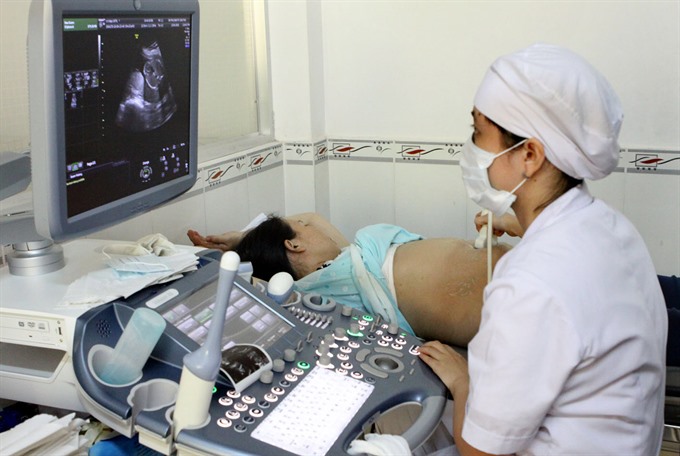 Society
Society

Preeclampsia is a condition which can not be avoidable for some pregnant women. It also is the second leading cause for maternal mortality in the world and in Việt Nam.
 |
| A nurse gives a pregnant woman an ultrasound scan to detect any complications which may arise during the pregnancy. — VNA/VNS Photo Dương Ngọc |
Gia Lộc
HCM CITY — Early this month, a 30-year-old pregnant woman in Cẩm Xuyên District in the north central province of Hà Tĩnh was brought to the provincial general hospital because of bleeding and shock caused by severe preeclampsia.
Preeclampsia, which is a disorder of vascular endothelial malfunction and vasospasm, often occurs at 20 weeks of pregnancy. However, signs of preeclampsia start to develop at six weeks. After child birth, the mother is at risk of preeclampsia or complications of this condition.
The hospital’s doctors examined the woman and gave her an ultrasound scan. They found that the 33-week-old fetus’s heart had stopped beating and had died.
The woman went into further shock and her blood pressure could not be measured. Immediately, she had to undergo emergency surgery to be saved.
She eventually recovered and was discharged from the hospital.
According to the World Health Organisation, more than 500,000 fetuses and newborns die due to preeclampsia in the world each year.
Huỳnh Nguyễn Khánh Trang, head of the Obstetrics Department at the Hùng Vương Hospital in HCM City’s District 5, said: “Preeclampsia is a condition which can not be avoidable for some pregnant women. It also is the second leading cause for maternal mortality in the world and in Việt Nam.”
"Severe bleeding after childbirth is the first cause," Trang added.
According to the Ministry of Health’s statistics released in 2010, for instance, the rate of maternal mortality relating to preeclampsia in the country was 17.4 per cent of the total deaths due to complications of pregnancy and childbirth.
It was estimated that more than 500 women died due to complications of pregnancy and childbirth in 2010.
High blood pressure is a sign of preeclampsia.
Of nearly 200,000 pregnant women at the hospital in the 2012-17 period, more than 2,800 had severe preeclampsia, which can cause complications of convulsions called eclampsia, HELLP syndrome, which is a rare liver and blood clotting disorder, pulmonary oedema and kidney and liver failure.
“Preeclampsia currently remains one issue which needs to be paid attention to in the country,” Trang said, adding: “Early detection and timely treatment will help reduce the rate of maternal death and raise the proportion of live births.”
Detection was mostly based on asking pregnant women about their family health history, he said, adding that fetal ultrasound and blood tests should be used for detection.
First-time mothers-to-be should check for preeclampsia. If they had preeclampsia in their first pregnancy or their mother or sister had preeclampsia, they are at higher risk.
Moreover, obesity is a risk factor for preeclampsia, Trang said.
Speaking at a scientific conference on gestation and prenatal diagnosis held last Friday in HCM City by the Hùng Vương Hospital, Dr Jon Hyett, a specialist in obstetrics and maternal and fetal medicine at Royal Prince Alfred Hospital in Australia, said that women with chronic kidney diseases, diabetes, chronic inflammatory disease called Lupus, or over 40 years old are at risk of getting preeclampsia.
According to a WHO recommendation, preeclampsia should be detected and appropriately managed before the onset of convulsions and other life-threatening complications.
Tăng Chí Thượng, deputy head of the city’s Department of Health, instructed that obstetrics and gynecology hospitals should use advanced techniques in prenatal diagnosis and treatment for pregnant women at high risk for conditions and diseases that can cause death.
They should provide technical assistance to hospitals with obstetrics and gynecology departments in provincial and local hospitals to help reduce maternal mortality, Thượng said.
Moreover, hospitals in the city should co-operate to save pregnant women with complications relating to pregnancy, he added. —VNS




